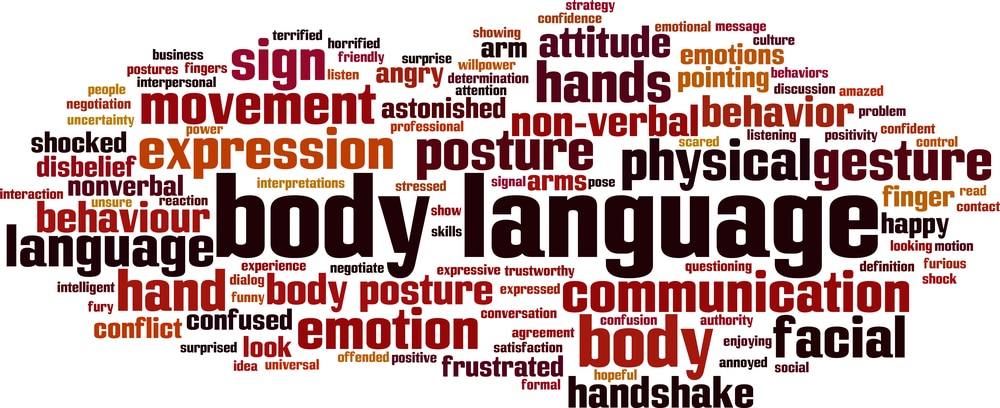Non-Verbal Cues in Conflict Resolution

Not every workplace conflict ends in a screaming match between two co-workers who don’t get on. In fact, it’s far more common for employees to show discomfort around another person through nonverbal cues.
These negative relationships in the workplace can be just as destructive as outright hostility and often worse. If management can’t identify that co-workers have a problem with each other and implement effective conflict resolution techniques, the issue can fester over months or even years.
This hurts employee well-being, productivity, and the overall culture in the workplace. It’s best avoided.
So, you must understand how to identify verbal and nonverbal cues in workplace communication. You need to understand conflict resolution best practices and know how to put them into action.
We also offer employee video-based conflict resolution training if that suits your needs better.
What are Non-Verbal Cues?
People express discomfort, anxiety, or dislike in numerous ways. Some people are forthright when they have a problem – while this can be useful in addressing an issue quickly, it can also exacerbate tensions.
Many people, especially in the workplace, prefer to keep their opinions on their co-workers to themselves, even if a co-worker behaves in a way that makes them uncomfortable. While this can be attributed to “professionalism,” it can manifest in less direct ways.
This is where nonverbal cues and non-verbal communication styles come into play.

Verbal Cues
Problems are virtually never resolved without verbal communication. At some point, someone will have to speak up on an issue. For this reason, some people consider it best to immediately state when they have a problem with a co-worker(this is often self-described as “being blunt”, “being honest,” or “telling it like it is.”
However, being willing to express an issue isn’t necessarily the same as being interested in resolving conflicts. If the issue is openly expressed, but there is no interest in collaborating or compromising to find a solution, these verbal cues can be deeply unhelpful.
Both non-verbal and verbal cues need to be brought to management’s attention so a constructive dialogue can occur.
Non-Verbal Cues
Many people express discomfort through body language, facial expressions, and other subtle nonverbal cues. This is generally to avoid “creating conflict.” Still, depending on how obvious the nonverbal cues are, they can hurt co-workers’ relationships without a word being spoken.
If two people work next to each other and one never smiles at the other, avoids speaking to them, and shows defensive body language when they’re around (e.g. folded arms), you can bet the other person has noticed.
Of course, if they haven’t, that’s also an issue! Many workplace conflicts stem from an individual failing to read another person’s body language, tone of voice, and other nonverbal cues and continuing with behavior that puts the other on edge. Teaching employees about what non-verbal cues can signal is very important for their relationships with co-workers.
Management personnel need to understand how and when employees will likely use verbal and nonverbal communication techniques to express disquiet. While it’s best practice to avoid closely monitoring personal relationships between employees (this can seem intrusive), management should be able to pick up on signs that an employee relationship isn’t in a good place.

Types of Non-Verbal Cues
Everyone has their own nonverbal communication style, and no list is exhaustive. However, it’s important to understand the most common types of nonverbal behavior and when they might be displayed.
We cover the major nonverbal cues below.
Facial Expressions
The human face is extremely expressive. Individuals will often adopt a “set” facial expression when conversing with someone they’re uncomfortable with.
However, this doesn’t necessarily mean they’ll be frowning or grimacing – rather, their expression remains constant throughout the conversation.
Indeed, some people deliberately smile when speaking to co-workers they have issues with. This is a masking technique to stop hostility from becoming public. These smiles are typically fixed and don’t change throughout the conversation, and they don’t reach the individual’s eyes.
More common facial expressions indicating underlying emotions include:
- A blank, detached expression
- Gazing away from the person into the distance
- Any fixed expression
- Openly hostile facial expressions (narrowed eyes, pursed lips, furrowed eyebrows)
Avoiding eye contact also sends unspoken messages – eye contact will be covered in detail below but may combine with other negative facial expressions.

Body Language
People often convey emotions through their body language. Management can gain valuable insights into a potential conflict by observing hand gestures, arm positions, and distance between people when they communicate.
Common body movement types that indicate discomfort include:
- Folded arms
- Stepping back
- Clenched fists
- Head titled back
- Staring at the ground
These nonverbal cues indicate that the individual wants the other party to get away from them. These are among the most common nonverbal responses, so they should be watched out for.
Besides body language indicating discomfort, management should also watch for employees’ domineering or aggressive body language. Individuals who communicate with aggressive gestures and intense eye contact or who tend to speak to others while leaning forward or over them may be causing discomfort among their coworkers.
Tone of Voice
While a verbal message may be perfectly reasonable in content, the tone in which it is delivered can tell a different story.
Management must show emotional intelligence by listening not just to what employees say, but how they say it. Being able to accurately read workers’ tone of voice helps make managers aware of potential issues and prevent future conflicts from arising.

Physical Distance
Personal space is very important in the workplace. Failing to mind co-workers’ personal space is a type of nonverbal cue indicating a lack of respect and an aggressive attitude.
Employees who are uncomfortable with their co-workers are more likely to use nonverbal behaviors like maintaining extra distance between themselves and the offending co-worker.
Note that different cultures have distinctive forms of human action, both spoken and nonverbal. Some cultures tend to stand closer or further apart when speaking, and management should be aware of this during the conflict resolution process.
Eye Contact
Maintaining eye contact is a critical part of human interaction. The eyes are very expressive, and refusing to look at someone when speaking to them sends a nonverbal message that you are guarded and don’t wish to show your true feelings.
Employees refusing to make direct eye contact with those they have a problem with is very common. It’s also a frequent hurdle for management during conflict resolution efforts – mediators will need to display emotional awareness and allow the individual to speak on their own terms to establish trust.
Identifying Non-Verbal Cues in Conflict Resolution
During the mediation process, managers should be acutely aware of their own nonverbal behavior and the messages it may send. Below, we outline techniques that management may use to foster positive human interaction and communicate effectively during the process. Training your employees on resolving conflicts is the goal of conflict resolution.
Active Listening
Active listening is a much more engaged type of listening, where you take care to show the speaker that you are attempting to develop a deep understanding of what they’re saying.
A common problem when resolving conflicts is that employees don’t feel “heard” by management – by ensuring that you’re fully present and focused on building trust, you can put the speaker at ease. This single gesture helps to guide the conversation toward the nonverbal messages the employee has been presenting and understand the root cause of the problem.

Remembering Nonverbal Cues
Make a mental note when you notice that nonverbal cues are present in personal relationships between co-workers. It may just be a one-off (everyone has bad days!) – but if you observe the same person communicating the same way repeatedly towards a co-worker through actions or words, it’s likely symptomatic of an underlying issue.
Showing Empathy
Management must show emotional intelligence and convey empathy when attempting to resolve a conflict. Active listening helps you develop an understanding of why certain nonverbal cues are present, but you must also make it clear that you consider any employees’ emotions valid and that you’re working towards a solution that will help them.
Empathy is a powerful tool. It can make you a better communicator and manager, and it’s central to conflict resolution.
Using Self-Disclosure
Addressing nonverbal communication includes encouraging employees to open up, which can be difficult when speaking to management. Self-disclosure, or showing your emotions and making it clear that you relate to the employee’s emotions and experiences, is essential.
Employees will be happier to talk about their own needs if they feel they’re speaking to a human being with emotional intelligence and not a corporate entity. This makes working through non-verbal communication techniques and toward constructive dialogue easier.
Addressing Nonverbal Cues in Conflict Resolution
Next, let’s discuss how management can approach effective conflict resolution to ensure that employees don’t feel “called out” on nonverbal cues. These are often defense mechanisms, so raising nonverbal cues as an issue needs to be handled delicately.
Raise the Issue Privately
Saying “Why the long face?” to a clearly uncomfortable employee is about the worst thing you can do.
If you’ve noticed an employee displaying nonverbal cues around a co-worker, raise the issue with them discreetly and privately.
Invite Each Party to Speak – Don’t Interrogate Them
Both (or all) parties need to be involved in communication to resolve the conflict. Each person should be given the opportunity to speak independently before being brought together to work through the issue.
While workplace conflicts shouldn’t be ignored, asking someone, “What’s wrong?” twenty times when they don’t want to talk isn’t a good idea. Leave it for another day.
Establish Boundaries and Professional Working Practices
It’s entirely possible and normal for two co-workers to not get along especially well. It must be understood that their workplace relationship should be professional and mutually respectful.
Nonverbal cues are an indicator that there’s a personal level of animosity. A resolution doesn’t have to involve friendship – but it should address gestures, body language, and other behaviors that show uneasy underlying emotions.
Keep an Eye Out for Nonverbal Cues Moving Forward
After mediation, do the nonverbal cues disappear, or are they still present?
Conflict resolution is often an ongoing process. Keep monitoring workplace relations after a conflict is “resolved” – you may need to return to the subject later if the issue persists.
Final Thoughts
Nonverbal communication is almost always evident in conflict resolution attempts – a skilled mediator understands how to interpret, approach, and discuss nonverbal cues without causing further discomfort.
Emotional intelligence is an ability that every manager should have, and it’s easy to develop with training and practice. Understanding how to approach and resolve conflicts in your workplace is an invaluable skill – make sure you’re prepared.
FAQ
What are nonverbal communication skills for conflict resolution?
Active listening is one of the most effective nonverbal communication skills. Empathy, self-disclosure, and receptive body language are all also important for mediators.
What Nonverbal and Vocal Cues Indicate Potential Conflict?
Crossed arms, fixed facial expressions, stepping back, and looking away from the speaker all indicate discomfort. Understanding how your employees communicate their feelings is extremely helpful for managers.
What are three examples of non-verbal cues?
- Vacant or unfocused expression when listening
- Staring at the floor
- A flat or expressionless voice tone when responding